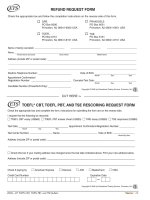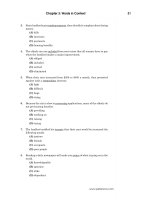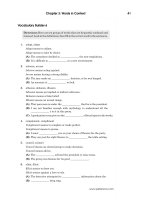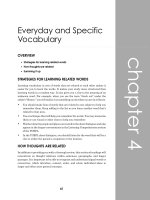Tài liệu 50 harvard essays part 5 pptx
Bạn đang xem bản rút gọn của tài liệu. Xem và tải ngay bản đầy đủ của tài liệu tại đây (373.12 KB, 10 trang )
Essays are for reference only. Do NOT copy or imitate anything!
Plagiarism is severely punished!
experiences as a performer, I am a more fulfilled person and I feel confident and
enthusiastic about future endeavors. I will continue to soar, free.
ANALYSIS
In her essay, the author of “To Soar, Free” demonstrates an understanding that if an
essay about a “significant experience or achievement” is to be successful, it must
distinguish itself from a pack of surely similar essay topics. Although the author’s
chosen topic is not all that different than writing about playing sports or performing
other types of art, this essay stands out. The author gracefully highlights the
personal importance of performing and teaching ballet, using her progression in the
art to reflect her personal and physical growth. Beginning with a childhood memory
about her first ballet performance, the author begins to paint a picture for the reader
of just how dance has influenced her life. From there, the reader gets a sense of the
increasing significance of this activity, to the point where he or she learns that this
love for ballet has inspired the author to instruct others in her art form. In her final
paragraph, the essayist closes with general conclusions about the lessons she
learned through dance.
By beginning her passage with an anecdote about her first major ballet performance,
the author distances her piece from a more straightforward
“what-dancing-means-to-me” essay. Instead of spelling out the reasoning behind
her love of ballet, the author encourages the reader to continue reading. Not until
the end of the fourth sentence does he or she know what exactly has been causing
the chills and excitement that the author illustrates so well in the opening sentences.
With a setting firmly established, the author is then free to proceed with her
narrative. The reader observes the author’s love of dance grew more intense as she
got older and became more serious about this activity. Moreover, in the third
paragraph, the author introduces an interesting twist to the essay, as she chronicles
her experiences on the other side of dance, as a ballet teacher at a summer camp.
This complication works well at illuminating the way in which the author learns to
see that ballet can offer more fulfillment than just that from the thrill of
performance.
Although this essay is effective at highlighting the many ways in which ballet has
affected the author’s life, it lacks flow and does not efficiently link its varied points
and ideas. The connection between the second and third paragraphs is especially
abrupt. This spot is an ideal juncture to suggest the many ways in which dance –
aside from its direct performance and practice – has influenced her life. Especially in
essays about significant personal experiences or achievements, it is extremely
important to make effective use of transitional phrases and words to connect the
individual points with the overall theme. Be that as it may, after compiling a solid
essay with unique perspectives and dimensions, the author subtracts from her piece
by offering clichéd conclusions in the final paragraph that are easy to incorporate
Essays are for reference only. Do NOT copy or imitate anything!
Plagiarism is severely punished!
into any essay of this form. The challenge is to identify and highlight conclusions
unique to the situation.
“One Hundred Pairs of Eyes”
“One Hundred Pairs of Eyes”
--by Patricia M. Glynn
Awareness. An awareness that all eyes from one hundred yards of green grass are
focused on a certain point in space is what drives through my thoughts as I stand
poised. These eyes disregard the peripheral chatter of spectators, the cold wind
whistling in the night air around them, and the harshness of the white lights over the
field. They focus only on this one spot before my hands and, to begin their show,
they wait for a simple motion, a mere flick of the wrist. As a tingling sensation arises
in my fingertips, I lift my hands in preparation. One hundred pairs of eyes breathe
in unison across the hundred yards, and my hands descend in a practiced pattern
toward that one point in space. It is that point where the hundred pairs of eyes
release their breath into their various instruments, where the music is created, and
where the show begins.
This experience is one that I get to relive every Friday night while conducting the
Plymouth High School marching band in its weekly half-time performance for the
football fans. While I have performed as one of the pairs of eyes, as conductor and
Senior Drum major I feel a greater part of the show than I ever did before. I feel
every note and every phrase of music from every instrument, and I pull even more
music from those instruments. Their intensity is sparked from my intensity, and
mine builds on theirs. The intensity is not only from the music; it comes from the
eyes. It’s my eyes scanning the field, scouting for problems, and brokering
confidence that command an intensity in response. This is the greatest feeling in the
world.
As my motions become larger and larger and my left hand pushes upward, I demand
volume from the band while it crescendos toward its final notes. Building volume
and drive, this music sends a tingling sensation from my fingertips through my
wrists and pulsing through my body. My shoulders ache but keep driving the beat,
and my emotions are keyed up. As the brass builds and the band snaps to attention
in the last picture of the show, the percussion line pushes the music with a driving
hit. Musicians and conductor alike climax with the music until reaching that same
instant in time. With a rigorous closing of my fists, the music stops, but the eyes
hold their focus, instruments poised, until a smile stretches across my face and my
features relax, tingling with pent up emotion. Applause.
Essays are for reference only. Do NOT copy or imitate anything!
Plagiarism is severely punished!
ANALYSIS
An essay that asks for discussion of an important extracurricular activity may be just
the place for an applicant to discuss in greater detail why participating in student
government makes his or her world go’ round. But as in this case, the essay may
also offer an opportunity for an applicant to further describe a unique or
unconventional interest. “One Hundred Pairs of Eyes” details the author’s
experiences as conductor of her high school football band – a position that on paper
may not carry much weight, despite its many responsibilities. Through her
description of leading one hundred musicians in the complexities of a half-time show,
the reader gains unique insight into being at the helm of a marching band – a
position from which few people have observed the perspective.
The author begins her essays with rich description –she is the point of focus for one
hundred sets of eyes. By personifying the eyes, the author paints a marvelous
picture of the scene. The reader can almost sense the position from which she must
be standing and the enormity of the group at her feet. But he or she is left to wonder
what sort of awkward situation may be causing this unique scenario. Just as the
author creates an intense sensation of tension in the essay, the reader too holds his
or her breath in advance of the announcement that Glynn is the leader of a marching
band. As she continues, the author contrasts her experiences as conductor with
those of being a performer, shedding light on the exhilaration of holding the gaze of
the hundred musicians who look to her for rhythm and tempo. And with descriptive
language in the third paragraph, the author encourages the reader to push onward,
toward the finale of both the music and the essay. The passage ends with an
impressive sense of relief both for the band members and the reader.
“The Lost Game”
“The Lost Game”
--by Stephanie A. Stuart
When I was little my father used to play a game with me driving home. Its main
substance was something like this: he would say, oh no, I seem to be lost; how shall
we get home? And then he would ask, which way? Gleefully, I would crane my neck
above the seat; according to the game, his befuddlement was hopeless, and I alone
as navigator could bring us home. No doubt I seemed contrary as I directed him
further and further down back streets, but my secret incentive was exploration. As
a small child there is very little one can control in one’s world; to have control over
an entire grown-up – not to mention a whole car – was tremendously appealing. The
Essays are for reference only. Do NOT copy or imitate anything!
Plagiarism is severely punished!
real allure, though, was in going the “wrong” way – as soon as we turned left where
we usually turned right, the world was so brand new it might have only appeared the
moment we rounded the corner. My heart would beat below my throat as I gave the
direction to turn, stretching my neck from my place in the backseat, eager and
afraid: suppose I did really get us lost? The secret desire to discover always won out
over the fear, but I can still recall the flutter of my heart on the inside of my ribs as
I navigated the roundabout connections which was as mysterious as the Northwest
Passage, lone link between the cul-de-sacs.
Exploration was a quest I took to heart; alone, I would set out on expeditions into
our back yard, or down the street, creating a mental map concentric to our doorstep.
Discovery bloomed magical for me; marked on the map were the locations of
abandoned tree houses, bell=blue flowers and plants with flat powdery leaves the
size of silver dollars.
The other night it fell to my brother and me to return a movie. After we left it on the
counter, though, our sense of adventure got the better of us. Oh dear, I said, I
seemed to be lost. Where shall I go? Eager to discover the town which smoldered at
one o’clock under the orange and violet of sodium street lamps, he chose the road
less traveled, at least by our wheels.
We wound into the pine forest in the dead of night; moonlight feel eerie across our
laps, stiated by tree trunks. I crested a hill slowly: Monterey spread in a lighted grid
below us, down to the darkening sea.
Above, the Milky Way sprang apart and arched like a dance. I angled my ear for a
moment to Gatsby’s tuning fork, that pure, enticing tone that echoes from the
spheres. Think, remember, I wished upon him, what it is to explore, and the
explorer’s incentive: discovery.
“Which way?” I asked him, and he grinned slowly, moonlight glinting far-off mischief
in his eyes. The streets spread orthogonal before us; the pure realm of possibility
opened from them.
“Straight ahead,” he said, and I smiled.
ANALYSIS
Stephanie’s essay falls into the life experiences category. However, rather than
focusing on a signle life-changing experience, Stephanie shows her approach
toward personal discovery by relating the sotry of riding in a car and changing the
standard directions as a means of stumbling upon unexplored worlds. The essay is
well controlled – at no point does she stray towward overstating the significance of
these individual events, but deftly uses them as a tool to illustrate her
adventure-seeking attitude toward life and her unwillingness to be satisfied with the
routine. Stephanie further highlighted the importance of discovery when she
submitted the essay to the admissions office on U.S. Geological Survey maps – a
thoughtful touch.
The essay’s greatest asset is the sense of personal development Stephanie conveys.
Essays are for reference only. Do NOT copy or imitate anything!
Plagiarism is severely punished!
What begins as a cute story of her childhood is used wonderfully to highlight her
personal development as she writes of a tenet in her life: “Think, remember … what
it is to explore, and the explorer’s incentive: discovery.” Stephanie avoids listing her
accomplishments in a resume put into sentence form, but still captures important
aspects of her identity, namely her inquisitiveness. The essay is well-paced and
calm, with a solid development from beginning to end. Stephanie describes sensory
aspects of her story (“flat, powdery leaves the size of silver dollars”) with great word
choice without overdoing it. It is clear that every word in the essay was carefully
chosen to accurately and succintly describe her subject. Not only does her essay
successfully paint a picture of her as an curious little child, it shows that the same
inquisitiveness she exhibited then she still possesses, now coupled with more
responsibility, as she drives her brother and encourages his inquisitiveness.
The biggest risk in this essay is that it does not adequately showcase her
accomplishments, normally a standard part of a college essay. While it worked for
her, this has much to do with the extraordinary level of care she took in crafting the
essay; her diligence shows, and the essay is an insightful, well-written, and
well-paced piece of work.
“Warm Hearts and a Cold Gun”
“Warm Hearts and a Cold Gun”
--by James A. Colbert
If a six-foot-tall man slinging a semi-automatic rifle had approached me in
Greenfield, I probably would have screamed for help. However, being in a foreign
land, unable even to speak the native tongue, my options of recourse were
significantly limited. The looming creature, dressed mostly in black, with short, dark
hair, proceeded to grasp my right hand. As a smile furtively crept across his face, he
mouthed, “Time to get on the bus.”
“What?” I nervously spurted at the cold weapon before me.
“I’m sorry. I didn’t introduce myself,” he said. “I’m Ofir, your counselor.”
Completely unnerved, I hurried onto the bus to be sure the gun remained at his side.
“Did you know one of our leaders is a guy with a gun?” I asked a girl from
Philadelphia, sitting beside me.
“What did you expect? This is Israel, not New England.”
At the end of my junior year I decided to go to Israel to escape from the stimulating
but confining atmosphere of Deerfield Academy. I yearned for a new environment
where I could meet students unlike the ones I knew, where I could explore a foreign
culture, and where I could learn more about my religion. The brochure from the
Nesiya Institute had mentioned a “creative journey” featuring hikes in the desert,
workshops with prominent Israeli artists, dialogues between Arabs and Jews, and
discussions on Israeli culture and Judaism, but nowhere had it mentioned









